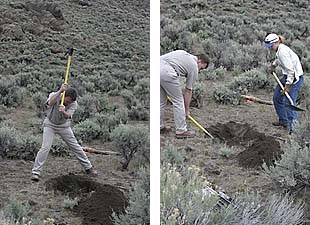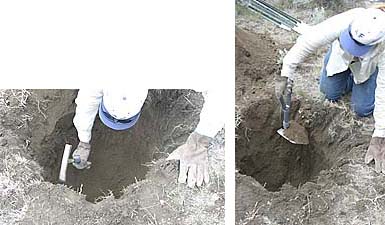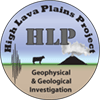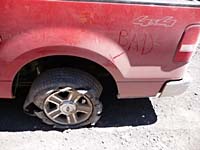Digging the Hole
The sensor vault consists of a plastic barrel, set in concrete and containing a bed of concrete in the bottom. In an ideal site, the hole for the barrel should be deep enough so that the top of the barrel is an inch or two above ground level and the bottom of the hole should be on bedrock. This, of course, rarely happens. The hole for the barrel should be circular, slightly larger in diameter than the barrel, and the bottom of the hole should be smooth and level. Suitable digging tools and techniques will vary depending on soil properties, but in general this progression is followed:

|
starting the hole with a mattock and shovels |

|
using the rock hammer and entrenching tools |
- Initially, break up the ground using a mattock or pick.
- Use shovels to remove the loosened dirt and rocks.
- Once the hole is more than about 1.5 feet deep, it becomes difficult to proceed with the mattock and shovel. Below this depth, it is useful to substitute a folding entrenching tool for dirt removal, and loosen the dirt with a rock bar or geologist's hammer.
- The rock bar is very useful for removing partially buried rocks, and for widening and trimming the sides of the hole.
You will need the dirt removed from the hole later, so keep it neatly in one pile. The location for the dirt pile should be carefully chosen so it will not be in the way of fencing or later station installation tasks.
Dry fit the barrel into the hole, to ensure proper depth and reasonably level bottom. Once the hole is dug and the barrel fits, it is time to Install the Barrel...


